CONVENIENCE AT A COST
Welcome to a guide on the privacy settings in Google Chrome – That you should know to protect yourself. Ah, the Internet. A gateway into the cyberworld, an endless ocean of contents and entertainment. But as you surf the Internet, the browser might also quietly collecting your information to “personalize your online experience”.
- Browsing history.
- Download history.
- Search history.
- Location history.
- Form auto-fill.
- Saved passwords.
- Payment methods.
Sure thing, some of these do make life easier, but tracking down to your exact location? Know all the websites that you have visited? Even with the assurance of “only you can see the history”, one cannot help but feel invaded. So in this guide, let us walk through some settings and tips on protecting your own privacy. Read on!
TABLE OF CONTENTS
 Section A Section APrivacy Settings |
 Section B Section BPrivacy Tips |
 Extra ExtraUseful Bits |
 Closing ClosingWhat’s Next? |
PRIVACY SETTINGS

Now, let us start with the settings in Google Chrome that you can use to control the “level of invasion”.
1) MANAGE YOUR GOOGLE ACCOUNT
BIG BROTHER IS WATCHING YOU
Yes, this is not a secret, and in case you do not already know – Google does keep track of a number of things that you do:
- What you search on the Internet (when you use the Chrome search bar or on Google’s website).
- Which websites you have visited.
- Audio recordings if you use Google Assistant (“Hey Google”).
- What you search on YouTube.
- Which videos you have watched and how long.
- Which locations you have been to (with Google Maps).
- Ads that you have watched and clicked on.
- Which devices you own.
- If you have bought stuff from the Play Store – Payment methods, and probably even your address.
Not all of these are bad though. Verifying the devices that you own actually adds to the security, audio recordings help to better understand your voice commands, and the YouTube search history does help to give better video recommendations… But a few of them are just pure creepy, like knowing the locations where you frequently visit.
P.S. No one in Google has direct access to all your online activities, nor can they reveal it. Under various laws internationally, Google can only disclose anonymous non-personal identifiable data. For example, fidget spinner is one of the top trends in mid-2017.
Yep… But even with assurance that all your online activity will remain private, the fact that it is just sitting online somewhere is quite jarring. So this first setting is actually not so much about Google Chrome, but your account on Google itself.
CONTROL ACTIVITY RECORDS
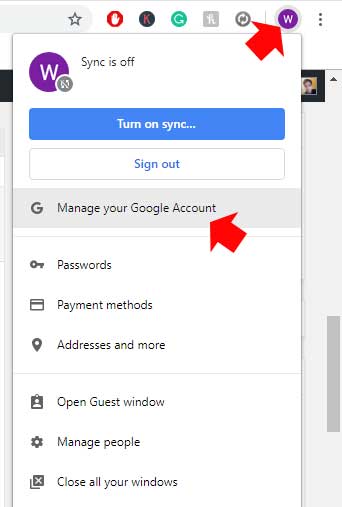
First, click on the user icon on the top-right corner > Manage your Google Account. You will be redirected online to https://myaccount.google.com.
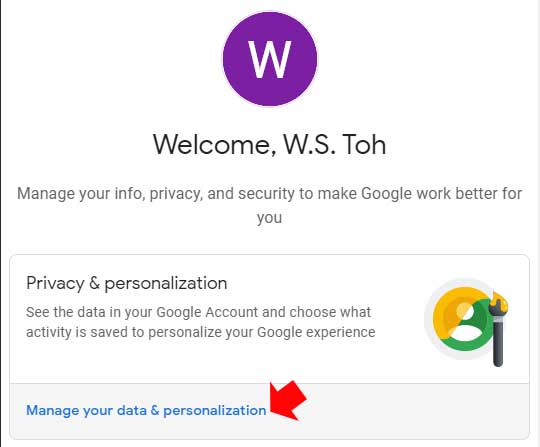
Click on “Manage your data & personalization”.
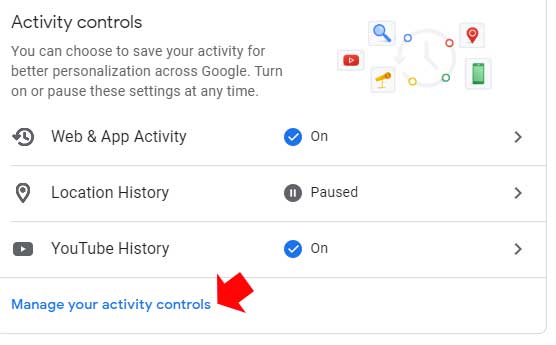
Click on “Manage your activity controls”.
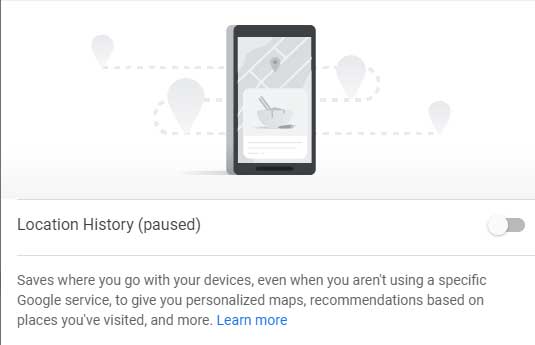
This is where you can control what Google keeps track of. I have turned off the YouTube watch history (creepy), voice recordings (I don’t use Google Assistant often), and the location history (very creepy). Feel free to turn off whatever you feel uncomfortable with.
2) CHANGE THE DEFAULT SEARCH ENGINE
If you have turned off the web activity, then Google should stop tracking your search queries and websites that you have visited. But if you are still worried, then consider switching your default search engine to DuckDuckGo – A search engine that aggregates results from various search engines. No tracking, no history, just results.
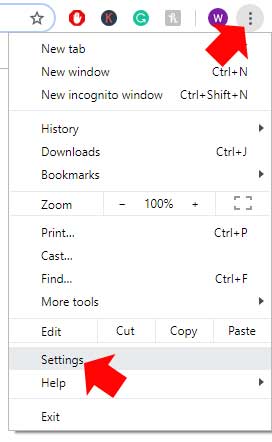
Hit the ⁝ button at the top-right corner > Settings.

Under the search engine section > Manage search engines. Then if DuckDuckGo is not already under the “other search engines” list, simply add it:
- Search Engine and Keyword – Just enter DuckDuckGo for simplicity, or name it whatever you want.
- URL –
https://duckduckgo.com/?q=%s&atb=v190-3__
Then press the ⁝ button beside Duck, set it as your default search engine.
3) ACCOUNT SYNC
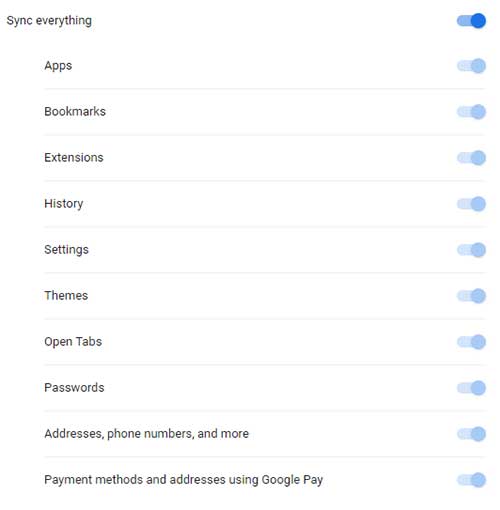
If account sync is enabled, all your bookmarks, installed extensions, saved users and passwords will be uploaded to your online Google account. Once you sign in Google Chrome on another device, all of this information will be restored (and synchronized).
This is particularly good as a backup, and if you want to have the same set of settings across many devices – A desktop, laptop, tablet, and smartphone. But otherwise, keep it disabled if you don’t feel safe with it.
- Simply click on the user icon on the top-right corner > Click on your account > Turn off sync (if it is on).
- If not, go into “Sync and Google Services” to control what you want to sync.
4) OTHER GOOGLE SERVICES
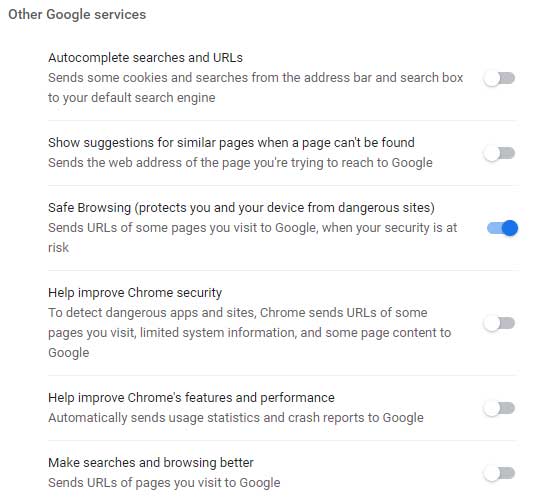
Right under the sync settings are some “really interesting settings” that you might want to disable:
- Say no to autocomplete search, no suggestions, don’t help to improve Chrome, and don’t send URLs to Google.
- The only “yes” here is probably safe browsing.
5) AUTO-FILL
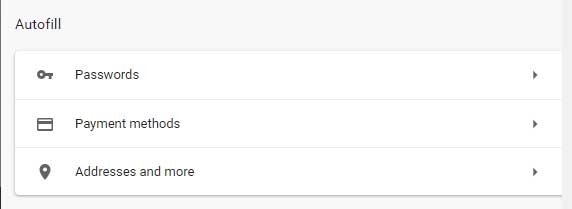
Yes, Google Chrome is quite smart and very convenient. It saves all your passwords, payment methods, and shipping addresses in an encrypted file. But guess what is safer? Don’t save any sensitive information at all.
- Hit the ⁝ button at the top-right corner > Settings.
- Under the “auto-fill” section, there are 3 different things that Chrome will save – Passwords, addresses, and payment methods.
I don’t quite mind the passwords as they really do save you from a lot of forgotten passwords, but the payment and address are a big no for me.
6) DO NOT TRACK, DO NOT CHECK.

This one is kind of a hidden mechanism, but some advertisers do track the products you have seen and your previous purchases. How else will they know what you are most interested in, and entice you with offers you will most likely pick up?
- Press the ⁝ button at the top-right corner > Settings
- Go under Advanced > Privacy and security
- I usually enable “send do not track”, and disable “allow sites to check for payment method”.
Yep. That will keep some pesky cyber salesman from following you around. But please take note that it is entirely up to the advertisers to abide by these rules you set – Some rogue marketers will simply ignore these, and keep tracking your sales history to show you “relevant ads”.
7) ACCESS PERMISSIONS
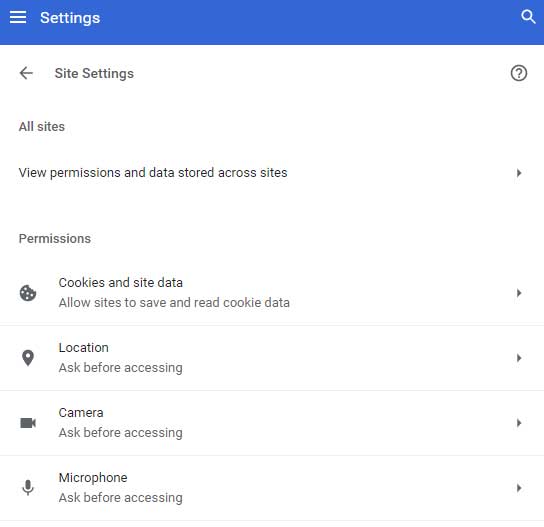
This website wants to access your location. That website wants to send you a notification. Ever allowed access permission by accident and not know where to remove it? Here’s how:
- ⁝ > Settings > Advanced
- Under “Privacy and security” > Site Settings
- This is where you can control all the site access permissions, and even permanently turn off access to your location for all websites…
OTHER PRIVACY TIPS

So far so good? Here are a couple more things you can do to step up the privacy game… If you really want to go that way.
INCOGNITO MODE
Don’t want Chrome to remember any of your search histories, visited websites, or use any of your previous sign in? Then switch on the incognito mode. Shortcut key ctrl-shift-n, or ⁝ > open a new incognito window. In this mode, it is like you are using a fresh copy of Chrome.
There are no linked Google accounts, and no history will be recorded – The moment this incognito window is closed, everything will be “flushed out”. But if you still sign on a website, that website will still have your login traces… Incognito mode is pretty much just “don’t remember anything in this session on this PC”, and not “total privacy protection”.
ANONYMOUS SURFING (PROXY SERVER)
Some of you guys may have heard of “anonymous surfing”. In actual fact, it is just asking another server to access websites on your behalf. Yep, please do be very careful with this one, as there are fake proxy servers that will actually collect your data while you surf “anonymously” – When you sign in to a website or make payments.
If you still want to “just check something”, here is a list of proxy servers recommendation by Lifewire.
VIRTUAL PRIVATE NETWORK (VPN)
What is safer than free proxy servers? VPN services. But of course, we are just bouncing off another server again, but in a more controlled manner. There is no true privacy on the Internet actually… Only how difficult it is to trace. If you are interested in VPN, I will recommend TunnelBear – This cuddly Canadian creature is one of the more reliable ones that I trust.
USEFUL BITS

That’s all for this tutorial, and here is a small section on some extras and links that may be useful to you.
DON’T BE TOO PARANOID…
Yes, privacy is important, protecting yourself is important too. But there is absolutely no need to go to the extremes of creating fake online profiles, buy a voice changer software, physically removing cameras, microphones, and checking outside the window every 10 minutes to see if you are being followed.
Going online is pretty much already a breach of privacy, interacting with the many netizens worldwide. So long as your critical information such as payment and physical addresses are not in danger of a security breach, then you are pretty safe – Just go enjoy the Internet as a “normal person”!
LINKS & REFERENCES
- 7 Essential Privacy Settings for Chrome OS and Google Chrome – Make Use Of
- How to Use Google Chrome Privacy Settings – Dummies
- 6 Chrome Privacy Settings You Need to Know About – Mommy Knows Tech
WHAT’S NEXT?

Thank you for reading, and we have come to the end of this guide. I hope this has helped you to better understand, and if you have anything to share with this guide, please feel free to comment below. Good luck and may the cyber force be with you.
